In hot weather, there is a possibility of your dog overheating, which can quickly become dangerous. To help you have a fun and safe summer with your furry friend, integrative veterinarian Dr. Julie Buzby discusses the reasons dogs overheat, the signs of overheating in dogs, and what to do if you think your dog is overheated. Plus, she shares some ways to prevent your dog from overheating.

Earlier this summer, I got a call from my best friend, Jennifer. As soon as I picked up the phone, I knew something was wrong.
In a worried voice, she told me that she thought Princess, her Boston Terrier, was overheated. The kids took Princess on a walk, and she was fine when they left. But when the kids came bursting through the door thirty minutes later, Princess was panting and drooling excessively.
I talked Jennifer through some of my methods on how to cool down a dog and discussed the signs of heat exhaustion versus heat stroke in dogs so she would know what to watch for. And I recommended she take her Boston Terrier to the local vet if her dog’s symptoms worsened.
When I called Jennifer to check on Princess an hour or so later, my dear friend sounded much calmer. And I was relieved to hear that her dog was back to her normal self.
Now that the initial scare had passed, Jennifer asked me why some dogs overheat so easily and what sort of warning signs to watch for so this wouldn’t happen again. I was happy to have this discussion with her. Jennifer and her family (human and furry) are dear to me. And I wanted to ensure they had all the tools and information necessary to keep Princess safe in the heat.
What is overheating in dogs?
As I explained to my friend, overheating happens when your dog’s body is not able to properly regulate its internal temperature. Normally, dogs have several natural cooling mechanisms that help them maintain their body temperature in a safe range, including:
- Panting—When a dog pants, he or she draws in air through the nose and mouth. As the air flows over the moist mucous membranes of the gums and inner nose, water evaporates from these areas. This helps lower your dog’s body temperature.
- Sweat glands in the paws—Just like humans, dogs have sweat glands. But while ours are all over our bodies, dogs only have sweat glands in their paws. So they sweat from their feet to cool down.
- Temperature-balancing properties of the fur—Many dog parents are surprised to learn that dogs’ fur actually helps keep them cool as much as it keeps them warm. Maintaining your dog’s coat at a proper length can also help prevent sunburns and protect the skin from cuts and injuries.
- Convection cooling—When dogs lie down on a cold surface (e.g., a cool floor), they can transfer heat from their body to that surface. This is a very effective means of cooling down.
However, sometimes the environmental temperature, a certain characteristic of the dog, and/or the dog’s activity level overwhelm these cooling methods. This leads to the dog overheating. And as the internal temperature continues to climb, the dog could develop heat exhaustion or heat stroke.
The climb from overheating to heat exhaustion and heat stroke
Think of internal body temperature as a ladder.
Rung #1: Normal temperature
Normal, ideal body temperature (99-102.5oF) is the bottom rung. This is where you want your dog to safely be standing. (As a side note, knowing how to take your dog’s temperature can be helpful for assessing which rung he or she is on. It isn’t the only factor to look at though.)
Rung #2: Overheating
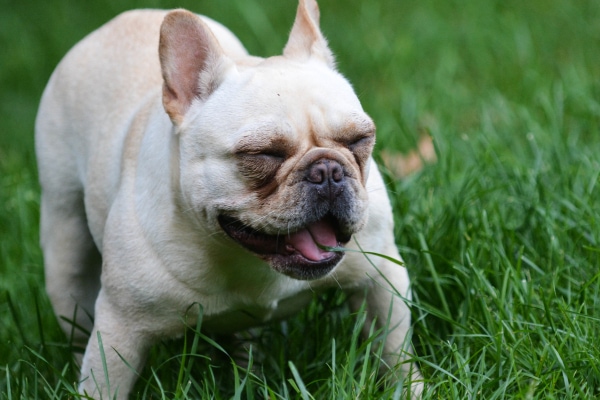
Overheating is the next rung. The dog’s temperature is slightly above 102.5oF, but it isn’t high enough to cause life-threatening issues yet. Overheating can occur for a variety of reasons, including:
- Improper natural self-cooling mechanisms
- Diseases that cause poor temperature regulation
- Breed predisposition to overheating
- Too much time and/or exercise outside in the sun and heat
Signs of overheating in dogs
We will spend more time talking about these factors in a bit. But first, let’s take a look at the signs of overheating in dogs, which can be subtle sometimes. They include:
- Panting
- Excessive drooling
- Looking for a cooler area to lie down (i.e. cold-seeking behavior)
- Increased thirst in dogs
- Being a lethargic dog
- Decreased energy
- Decreased appetite
- Audible breathing noises
Dogs who are overheated may show one of these symptoms, all of them, or none of them. Overheating isn’t always obvious and doesn’t usually cause easy-to-notice signs like throwing up and diarrhea. This can sometimes make it challenging to tell if a dog is overheated.
Rung #3: Heat exhaustion
Heat exhaustion is the third rung on the ladder. Now your dog is getting a little higher up and is farther away from the safety of the ground and bottom rung. Typically, when your dog is experiencing heat exhaustion, his or her temperature will be over 103oF but below 105oF. And often he or she has been in a warm environment and/or exercising.
Signs of heat exhaustion
Heat exhaustion has some of the same symptoms as overheating, but they tend to be more pronounced. Common signs include:
- Lethargy (which often progressively worsens)
- Increased panting and drooling
- Weakness
- Dizziness
- Vomiting
- Trying to find a cool spot to lie down
If you do not get your dog to a cool environment and lower his or her body temperature, heat exhaustion can progress to the final and top rung of the ladder—heat stroke. Heat exhaustion is not always an emergency; however, heat stroke is an emergency every time.
Rung #4: Heat stroke
Heat stroke in dogs occurs when your dog’s body temperature is so high that the body can no longer function properly. This can happen when the temperature reaches 105oF. But the symptoms (and damage to the body) rapidly worsen when your dog’s temperature is 108-109oF.
Signs of heat stroke
Some heat stroke symptoms include:
- Excessive panting
- Excessive drooling
- Incoordination
- Lethargy or sudden sleepiness
- Vomiting or diarrhea (sometimes bloody)
- Collapse or inability to stand
- Seizures in dogs
- Blue, brown, red, or pale gums
- Bruising or abnormal bleeding
- Mental dullness or loss of consciousness
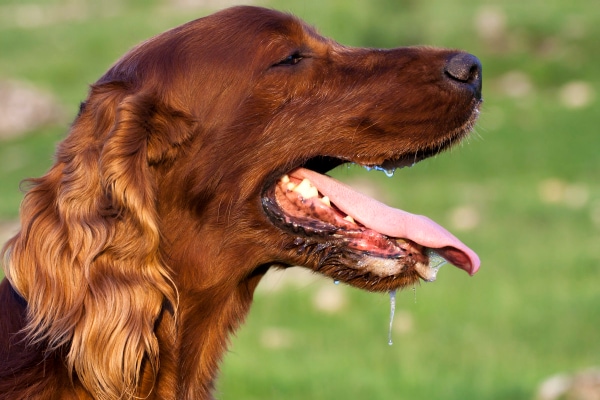
As you can see, some of the symptoms of heat stroke are similar to those of overheating and heat exhaustion. But, heat stroke is more serious and progresses quickly.
Heat stroke will eventually cause a dog to be so weak that he or she collapses. If the temperature reaches 108-109oF, it can cause seizures and permanent damage to a dog’s organs and body. Too high of a body temperature can lead to kidney failure in dogs, intestinal bleeding, inability to properly clot blood, swelling of the brain, brain damage, and eventually death.
Therefore, if you think your dog may have heat stroke, make an emergency vet visit right away. You can quickly mist your dog with cool (not cold) water and turn up the air conditioning in your car on the way there (or open the windows) to help your dog start cooling off.
What do I do if my dog is overheating?
If, on the other hand, you believe your dog is overheating or starting to develop heat exhaustion (but does not have heat stroke or severe heat exhaustion), you can to take steps to help cool down your dog at home.
1. Go inside
The best way to cool down an overheated dog is to take him or her inside (away from the heat) and encourage your dog to relax while drinking water. Move your dog into the house (or car if you are away from home) and turn on the air conditioning. Should you not have AC, try to find a cool room in the house and turn on a fan.
It is very important to get your dog out of the heat and sun. Otherwise, he or she will not be able to cool down.
2. Give your dog a cool spot to lie down
Encourage your dog to lie down in a cool area with good airflow. If needed, relocate your dog’s favorite bed or toys to that location to help persuade him or her to relax there. Also, take a look at where in the room the bed is. When possible, I recommend moving it away from windows or glass exterior doors because the heat from the sunlight can further raise an overheated dog’s temperature.
On the other hand, many dogs want to lie down on a cool surface rather than a bed. This is because convection is one of the two main ways they regulate their body temperature (the other is panting).
Some dogs may choose to sprawl on the hardwood or tile floor. However, senior dogs with arthritis or dogs with orthopedic problems may not enjoy sleeping on hard surfaces. Therefore, they might greatly prefer lying on a cooling mat.
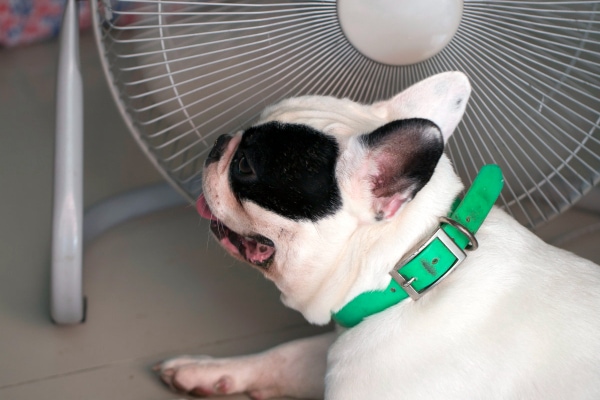
I love cooling mats because they transfer heat away from the dog efficiently and are so much more comfortable for the dog than the floor. Plus, many dogs find them relaxing, which can encourage your dog to lie down in one place and rest.
I mention this because it is important for dogs to be calm when cooling down. If you take your dog inside but he or she is still running around playing, the body temperature isn’t going to go down much. In fact, it might even go up.
If you think your dog is too hot but he or she still wants to play, consider putting your dog on a leash. Then sit down with your dog and his or her favorite safe chew toy for dogs. This can help motivate your dog to lie down and rest.
3. Use an ice pack
If, after getting your dog to lie down and relax, you think he or she needs some additional cooling, it might be tempting to drape cool wet towels over your dog’s body. However, this can actually trap heat and prevent your dog from cooling down.
Instead of reaching for a wet towel, grab an ice pack and a dry towel to wrap around it. Ice packs aren’t necessary for all overheated dogs, and they typically aren’t effective when used alone. But they can be a useful additional cooling method as long as you use them safely.
Always wrap the ice pack in a thin towel or cloth before applying it to your dog’s skin. And don’t use an ice pack for more than 15 to 20 minutes, especially in one location. Placing the ice pack directly on your dog’s skin or holding it in place too long can cause cold burns.
The most effective places to use the ice pack are the armpits, neck, and groin (i.e. area between the hind legs). These areas have less hair and a higher concentration of surface blood vessels, which helps with cooling.
(Safety note—only apply the ice pack to one of these locations and never place your dog in an ice bath or cold water. Applying multiple ice packs, or using an ice bath or cold water, can cause widespread constriction of the surface blood vessels, which can be dangerous for your dog.)
Generally, I recommend removing the ice pack and checking the skin for redness or irritation every five minutes. If the dog’s skin looks ok and he or she is tolerating the ice pack well, you can continue the cold packing for another increment of five minutes (up to a total application time of 15 to 20 minutes).
4. Ensure your dog has plenty of water
I mentioned it earlier when we talked about bringing your dog inside, but I want to emphasize it again. Always remember to ensure that clean, cool water is easily accessible for your dog to drink. Rehydrating is one of the most important parts of the treatment for an overheated dog. Dehydration plus a high body temperature increases the risk of your dog developing heat exhaustion or heat stroke.
You may want to put fresh water in your dog’s bowl and set it right next to where he or she is lying down. That way he or she can drink at will while also cooling down.
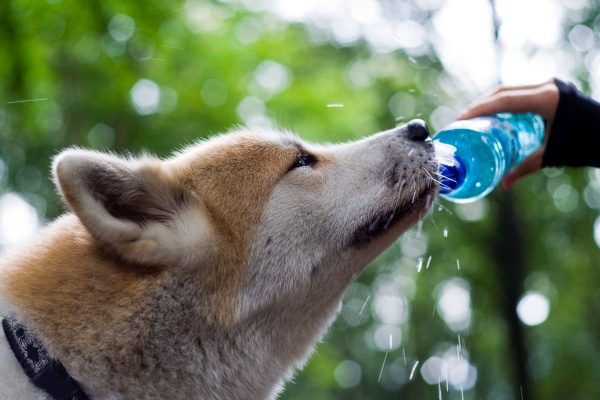
When do I need to call the vet for an overheated dog?
If you have tried to help your dog cool down, but he or she still appears to be overheating, or if you see any heat stroke symptoms (collapse, mentation changes, abnormal gum color, seizures, etc.), it is time to call your veterinarian.
Unfortunately, dogs can die from overheating that then progresses to heat stroke, and hundreds do each year. So if you have any doubt in your mind about how your dog is doing or what rung of the “heat-related illness ladder” he or she is on, it is best to get to the vet ASAP.
It is easier and more effective to make a vet visit for a dog who is overheating or experiencing heat exhaustion before it becomes heat stroke. Plus, it is a lot more likely to end well.
What can you expect at the vet?
The first thing your vet will probably do is take your dog’s temperature and quickly examine him or her. This allows the vet to determine how serious the heat-related illness is. Then, the veterinary team will get to work cooling and stabilizing your dog.
Some of the assessments and treatments they might use include:
- Administering IV fluids to provide hydration to your dog and promote cooling
- Running blood tests to assess organ function, blood clotting, and blood cell numbers
- Wetting your dog’s fur and putting him or her in front of a fan and/or on a cool surface
- Providing oxygen therapy to help a dog breathe easier
- Administering medications to stop vomiting or to protect the stomach lining
- Providing a blood or blood product transfusion to manage abnormal clotting
- Administering medications to reduce brain swelling
Often, dogs who have heat stroke may need to be under the care of a veterinarian for at least 24 hours. This means that if you went to your family vet for the initial treatment, he or she might recommend transferring your dog to a 24-hour center for overnight monitoring and continued treatment.
Unfortunately, once true heat stroke develops, the prognosis is guarded to poor. Dogs can and sometimes do recover from heatstroke. But it takes early detection on the part of the dog’s parents and intensive treatment and monitoring on the veterinary team’s part.
Why is my dog overheating?
As you can see, the heat can be dangerous for dogs. This can make it seem like you shouldn’t ever let your dog outside in the summer. But I want you to know that it is still okay (and important) to enjoy time in the sun with your furry friend. Dogs need to get outside to explore and sniff the world around them. And they enjoy the chance to play with their people and participate in summer fun.
In order to keep your dog safe, it can be helpful to know a bit about how and why dogs overheat in the first place. Any dog is at risk of overheating—especially during the hottest hours of the day. However, some dogs will overheat even when it is not that hot outside. Usually, this is because he or she has some “overheating risk factors.”
Brachycephalic dogs
Sometimes dogs will overheat easily because they have difficulty breathing properly. This is especially true of brachycephalic dog breeds (i.e. dogs with flat faces). Their skulls are shorter than other breeds and their nose is squished.
Due to this face shape, the nasal passages of brachycephalic breeds are also shorter and narrower than those of other dog breeds. This, combined with small nasal openings and a soft palate that may be too long, means that brachycephalic dogs have limited airflow.
Therefore, these breeds have a decreased ability to breathe properly and regulate body temperature—especially when playing or exercising. Even if the weather is not blazing hot, long walks or playing outside on a nice day can be enough for flat-faced breeds to get overheated.
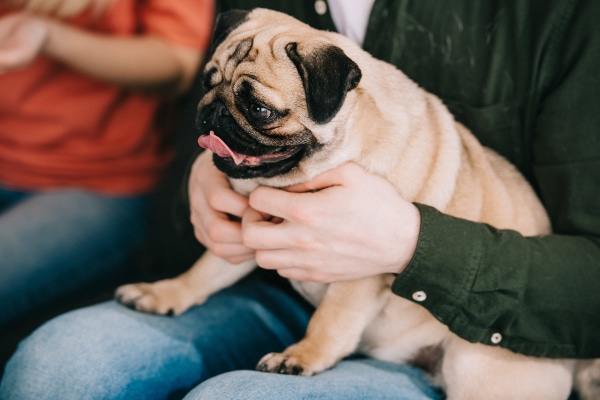
While not an exhaustive list, some common brachycephalic dogs include:
- Pugs
- French and English Bulldogs
- Lhasa Apsos
- Boston Terriers
- Boxers
- Pekingese
- Shar-Peis
- Shih Tzus
- Chow Chows
Senior dogs and puppies
In addition to brachycephalic dogs, senior dogs are also at increased risk of overheating. As dogs age, so do their bodies. They can develop other diseases that affect their normal cooling mechanisms. Plus, senior dogs may have osteoarthritis in dogs or quickly become weak in the heat, both of which can make it difficult for them to carry out the tasks they need to cool down (e.g. get up to move to a cooler place or walk over to the water dish).
On the other hand, puppies are also prone to overheating. Just like human babies, puppies have not fully developed the ability to regulate their body temperature properly yet. This makes them more likely to overheat even if the weather is not extremely warm.
Dogs with certain diseases
In addition to age, some diseases or conditions can also make dogs more likely to overheat easily.
For example, having heart disease in dogs or other lung or heart problems can put dogs at increased risk of overheating. Dogs with these conditions are more likely to have difficulty breathing and can tire quickly. This makes it challenging for them to cool themselves efficiently.
Along the same lines, dogs with upper airway problems can overheat easily as well. Just like brachycephalic dogs, these dogs can have a hard time breathing properly and regulating body temperature. Some examples of upper airway diseases include:
- Collapsed trachea in dogs
- Laryngeal paralysis in dogs
- Rhinitis in dogs (i.e. inflammation of the nasal passages) or other nasal diseases
- Upper airway obstruction (sometimes caused by a mass)
- Tight airways and difficulty breathing secondary to severe allergies
Dogs who have upper airway disease often make loud, wheezy, or whistling sounds when breathing. And you might notice these dogs coughing or gagging. Additionally, they can have increased difficulty breathing when exercising or playing.
If your dog has any of these conditions, it is extremely important that you use extra caution when walking or playing so your dog doesn’t overheat. Also, if you haven’t already, it is important to talk to your vet about ways to manage your dog’s disease.
Overweight dogs
Another condition that can make dogs prone to overheating is being overweight or obese. Extra body weight can act like extra insulation for a dog. This decreases a dog’s ability to cool down and prevents him or her from being able to regulate internal body temperature as effectively, especially during strenuous exercise.
If you are asking yourself, “Is my dog overweight?” please talk to your veterinarian or learn how to find your dog’s body condition score (BCS). Should you determine that your dog needs to shed a few (or a lot) of pounds, your vet can also work with you to help your dog lose weight.
Being in specific situations
Dogs who fall into the categories above are more likely to overheat easier and more often—even if it isn’t very hot outside. But even the healthiest dog can overheat in certain situations, including:
Spending long periods of time outside in hot weather
If it is a hot, summer day and you are outside playing with your dog, it is possible that he or she can overheat. Even if you are playing in the water or swimming, the outside air can still be warm enough to overwhelm your dog’s cooling mechanisms.
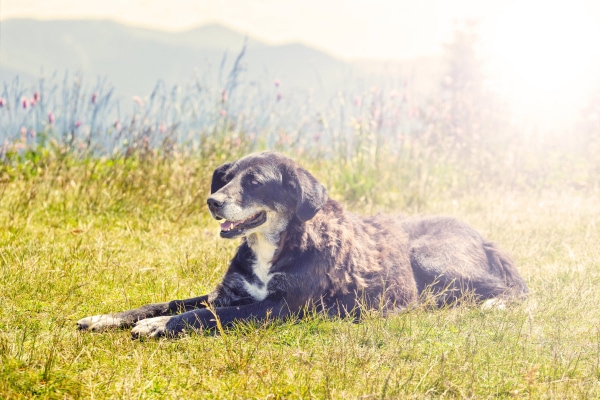
It is important to take breaks and encourage your dog to relax during them. Also, if it is hot outside, be sure to go inside to escape the sun every couple of hours. Even though it is fun in the sun, dogs need to go inside to cool down.
Being left inside a parked car
Many dogs love going on car rides, so it can be tempting to let your dog ride along with you in the summer. However, this can quickly become dangerous if you leave your dog in the car (even if you are just quickly running in somewhere).
When you are driving, the air conditioning or the breeze from having the windows down can help keep your pup cool. This isn’t the case for a parked car, though.
According to multiple studies, if the outside air temperature is more than 60oF, the temperature inside a parked car can increase by 20oF in only 10 minutes. In 20 minutes, the internal car temperature can rise by 30oF. And if your dog is in the car for an hour, the temperature can rise by over 40oF.
I often hear people say that they put the windows down and park in the shade so their dog doesn’t get too hot. However, research has also shown that car covers, parking in the shade, and leaving windows down do not keep the car cool enough for your dog to be safe. Even if you do those things and provide water, a dog left in the car can overheat and become seriously ill or die.
Staying in a space with limited airflow
Being stuck in a car, shed, garage, plastic crate, or other confined spaces with limited airflow can also make a dog more likely to overheat. Small spaces with poor ventilation are often warmer and do not allow a dog to cool down enough to avoid overheating.
Being dehydrated
Maintaining proper hydration in hot weather is key. Dogs who are dehydrated are more likely to become weak and tired quickly. Proper hydration also provides good blood flow to the surface of the body to dissipate heat and promotes the process of evaporative cooling during panting. Therefore, whether you are home or outside exploring, ensure your dog is drinking plenty of water. And plan to bring water with you on any outdoor adventures.
Engaging in strenuous or prolonged exercise
Especially for a dog who isn’t in good shape or accustomed to the heat or humidity, exercise can also cause dogs to overheat. Throwing the ball for your dog for an hour or going on a long run on the first hot (or warm) day of the year could potentially lead to your dog overheating. So could taking a couch-potato dog on a long or strenuous hike, running, or swimming on a hot day.
Of course, these are not the only scenarios where a dog can become overheated. But they do tend to be the most common reasons for a dog overheating. Keeping these scenarios and conditions in mind can help prevent heat-related problems.
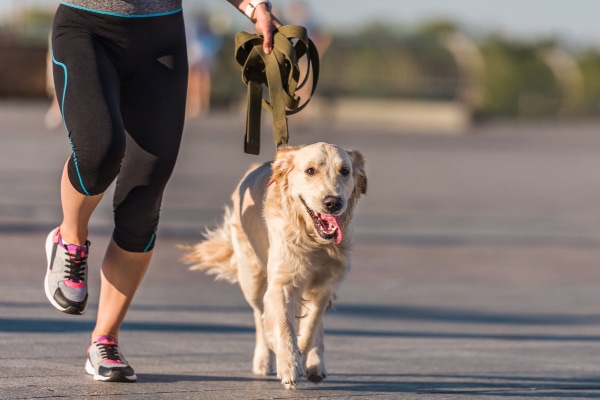
How can you keep your dog from overheating?
Additionally, you can take that knowledge and turn it into concrete steps to take to help your pup stay safe in the heat. I have already alluded to many of them, but I wanted to compile them into these six summer safety tips.
1. Provide your dog with fresh water 24/7/365
Your dog should have access to clean, fresh water all the time. Drinking from a lake or puddle while camping or hiking is not enough. Instead, get into the habit of bringing water for you and your dog everywhere you go.
2. Take breaks often
It’s great to spend time outside, but it is important to take your dog inside with you multiple times a day to cool off and rest. If you have been outside with your dog and are starting to feel overheated or exhausted, it is likely that your dog is as well. Bring him or her inside with you to decrease the risk of overheating.
3. Do NOT exercise at-risk dogs in the heat
In the hot days of summer, dogs who are at increased risk of overheating (e.g., brachycephalic dogs, senior dogs, and puppies, dogs with respiratory or cardiac conditions, and overweight dogs) should NEVER exercise in the heat. Walks and playtime should be in the early morning before the heat of the day or in the afternoon or evening when temperatures begin to drop.
4. Bring your dog inside on extremely hot days
If it is too hot for you to be outside, it is too hot for your dog. Providing shade and water is not enough—bring your dog inside to cool down.
5. Don’t leave your dog in the car
NEVER leave your dog in a parked car—even if it is in the shade with the windows down. If you need to run errands, it is always best to leave your dogs at home. The joy they get from the ride is not worth the risk!
6. Know your dog’s limitations
No one knows your dog as well as you do. Monitor your dog when enjoying the great outdoors and watch for subtle changes in his or her behavior. You are the best person to detect when something is wrong. If you notice that your dog is too warm, take a break and help your dog cool off.
Have a PAWsitively safe and enjoyable summer
These are the same tips I shared with my friend Jennifer. And then she passed them on to her kids. Ever since that scary day, Jennifer’s whole family has done a great job of monitoring Princess very closely. The kids still take her on walks every day—but only in the early morning or evening when the temperature is not as hot. And Princess and Jennifer have continued to safely enjoy spending time outside together too.
The same can be true for your dog and your family. I know it can be scary to hear about all the dangers of overheating. But by keeping what you have learned in mind, you and your dog can have a fun (and safe) time outside in the warm weather.
How do you keep your dog from overheating?
Please comment below.


Some electric cars are able to run AC while parked.
My dog is a car fanatic and since acquiring our new EV I am able to take him shopping etc.
Recently saw a Tesla parked in the sun with windows closed and dog inside.
It’s screen read no worries the AC is on.
CONFUSED… 2 QUESTIONS:
I just saw a post where they were saying NOT to put cold water or wet towels on the back of an overheated dog because: “Due to the cold, the veins contract and due to the high temperature (above 42 degrees), the proteins in the blood clot, which makes the blood thick and viscous.
Due to the combination of the two, the heart can no longer get the blood and the organs fail one by one due to lack of oxygen.
The result is a very slow but very painful death.”
– Is this true?
– Is it a risk when applying ice pack to the arm pits, neck, and groin?
Thanks for your information, I love your blog!
Hi Marie,
Thank you for bringing this important conversation to our attention! There is conflicting information about whether ice packs are beneficial or harmful. The application of multiple ice packs or an ice bath can cause widespread constriction of surface blood vessels. The negative side effects you mentioned are possible, but rare, and usually only occur in extreme conditions. Just to be cautious, a safety note has been added to this section of the article. We appreciate your feedback!